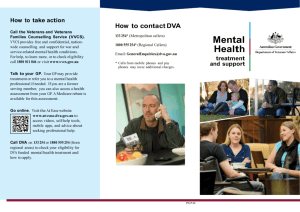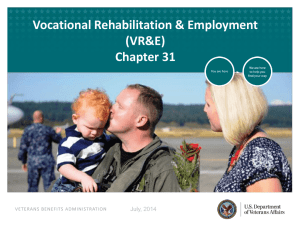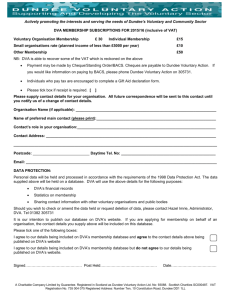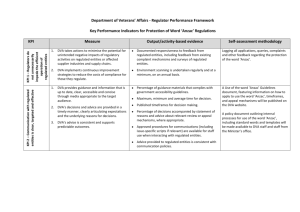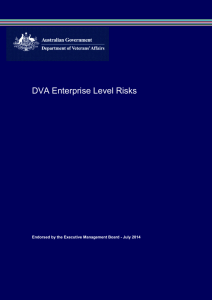2015-16 DVA Budget Factsheet (DOCX 248 KB)
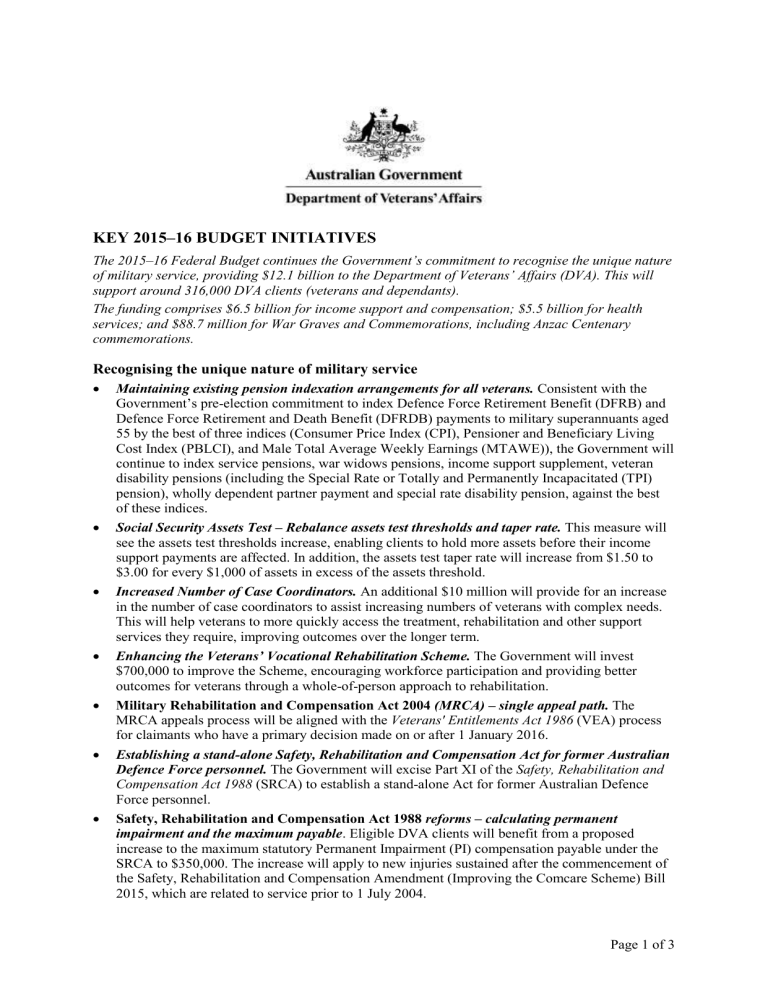
KEY 2015–16 BUDGET INITIATIVES
The 2015–16 Federal Budget continues the Government’s commitment to recognise the unique nature of military service, providing $12.1 billion to the Department of Veterans’ Affairs (DVA). This will support around 316,000 DVA clients (veterans and dependants).
The funding comprises $6.5 billion for income support and compensation; $5.5 billion for health services; and $88.7 million for War Graves and Commemorations, including Anzac Centenary commemorations.
Recognising the unique nature of military service
Maintaining existing pension indexation arrangements for all veterans. Consistent with the
Government’s pre-election commitment to index Defence Force Retirement Benefit (DFRB) and
Defence Force Retirement and Death Benefit (DFRDB) payments to military superannuants aged
55 by the best of three indices (Consumer Price Index (CPI), Pensioner and Beneficiary Living
Cost Index (PBLCI), and Male Total Average Weekly Earnings (MTAWE)), the Government will continue to index service pensions, war widows pensions, income support supplement, veteran disability pensions (including the Special Rate or Totally and Permanently Incapacitated (TPI) pension), wholly dependent partner payment and special rate disability pension, against the best of these indices.
Social Security Assets Test – Rebalance assets test thresholds and taper rate.
This measure will see the assets test thresholds increase, enabling clients to hold more assets before their income support payments are affected. In addition, the assets test taper rate will increase from $1.50 to
$3.00 for every $1,000 of assets in excess of the assets threshold.
Increased Number of Case Coordinators.
An additional $10 million will provide for an increase in the number of case coordinators to assist increasing numbers of veterans with complex needs.
This will help veterans to more quickly access the treatment, rehabilitation and other support services they require, improving outcomes over the longer term.
Enhancing the Veterans’ Vocational Rehabilitation Scheme.
The Government will invest
$700,000 to improve the Scheme, encouraging workforce participation and providing better outcomes for veterans through a whole-of-person approach to rehabilitation.
Military Rehabilitation and Compensation Act 2004 (MRCA) – single appeal path. The
MRCA appeals process will be aligned with the Veterans' Entitlements Act 1986 (VEA) process for claimants who have a primary decision made on or after 1 January 2016.
Establishing a stand-alone Safety, Rehabilitation and Compensation Act for former Australian
Defence Force personnel.
The Government will excise Part XI of the Safety, Rehabilitation and
Compensation Act 1988 (SRCA) to establish a stand-alone Act for former Australian Defence
Force personnel.
Safety, Rehabilitation and Compensation Act 1988 reforms – calculating permanent impairment and the maximum payable . Eligible DVA clients will benefit from a proposed increase to the maximum statutory Permanent Impairment (PI) compensation payable under the
SRCA to $350,000. The increase will apply to new injuries sustained after the commencement of the Safety, Rehabilitation and Compensation Amendment (Improving the Comcare Scheme) Bill
2015, which are related to service prior to 1 July 2004.
Page 1 of 3
Safety, Rehabilitation and Compensation Act 1988 reforms – multiple injuries arising out of the one event . This initiative will allow multiple conditions that arise from a single event to be combined and treated as a single injury to meet the minimum threshold for PI lump sum compensation under the SRCA. As a result, more DVA clients are likely to receive PI compensation.
Ongoing Restoration of Funding for Building Excellence in Support and Training (BEST)
Programme.
Consistent with the Government’s pre-election commitment, the Government will permanently re-instate the $1 million a year, which was cut by the former government, to the
BEST programme. This funding enables ex-service organisations to continue to provide support and resources to pensions and welfare officers and advocates.
Keeping veterans and their families healthy
Extension of Trial for In-Home Telehealth for Veterans.
An additional $3.7 million will extend the existing trial for in-home telehealth for veterans by a further 18 months. The trial is assessing home-based monitoring of DVA patients as a safe, effective and efficient complement to general practitioner (GP) consultations. This initiative potentially provides an opportunity to support patients longer in their own homes and delay their entry into residential care.
Repatriation Pharmaceutical Benefits Scheme (RPBS) – new listings and price amendments.
This initiative allows for new and amended listings to be made to the RPBS, such as the listing of a generic medicine for osteoporosis or to cover the changes to prices of products used to dress wounds or treat intractable rhinitis.
Expansion of the Rehabilitation Appliances Program (RAP) to Enhance the Delivery of Falls
Prevention Items.
RAP enhancements include several falls prevention items in the Schedule and removal of duplication across similar activities. The expansion of the RAP Schedule ensures that it continues to be appropriate and effective in meeting the clinical needs of eligible veterans in the community. This initiative was previously reported in the 2014–15 Additional Estimates
Statements.
DVA commemorative initiatives – Anzac Centenary
Anzac Centenary Program 2014–18 – additional funding.
$35.5 million will allow up to 10 additional commemorative services to be held at national memorials in Australia, for example for the 50th anniversary of the Vietnam War, and the 75th anniversaries of the Fall of Singapore and completion of the Thai-Burma Railway. It will also provide for additional international commemorative services at Lone Pine, Fromelles and Pozieres, Polygon Wood, Be’er Sheva, and
Le Hamel.
Official Histories. Funding of $8.7 million will allow the Australian War Memorial to produce an official history of Australia’s involvement in Iraq, Afghanistan and East Timor.
Sir John Monash Centre – Villers-Bretonneux, France.
This $99.5 million project is being funded with $88.6 million from the Department of Defence and $10.9 million from DVA. The
Centre will tell the story of the 290,000 Australians who served on the Western Front in the First
World War and is scheduled to open before Anzac Day 2018.
Other Government initiatives affecting DVA clients
Department of Social Services
Aged Care – increasing short-term restorative care places.
This measure will expand the number of short-term restorative care places from 2016–17. Restorative care is intended as a short-term, intensive intervention to help older people regain independence and function after a setback, such as an illness or a fall, and assist them to remain living in their own home. DVA will pay any client contributions that may be relevant for these places for former Prisoners of War and Victoria Cross recipients.
Page 2 of 3
Aged Care – alignment of aged care means testing arrangements.
For all people entering residential aged care from 1 January 2016, rent from their former principal residence will now be included in the aged care means test.
Aged Care – Home Care Programme – increasing consumer choice.
From July 2018, the
Government intends to establish a single, integrated care-at-home programme, combining the existing Commonwealth Home Support Programme and home care packages. DVA will work with the Department of Social Services to explore potential opportunities and linkages between these reforms and DVA community care programmes, such as Veterans’ Home Care.
Improving the Integrity of Social Security Income Test Arrangements. This initiative will increase the proportion of defined benefit income streams that are assessed under the social security income test by capping the proportion of income that can be excluded from the income test at 10 per cent. However, income streams from a defined benefit military superannuation fund are excluded from this measure, as are defined benefit income streams held by DVA service pensioners and income support supplement recipients.
Department of Health
Pharmaceutical Benefits Scheme – increase in the safety net threshold on 1 January 2019.
From 1 January 2016, the pharmaceutical safety net threshold will increase by two prescriptions a year, with the threshold reaching 68 prescriptions from 1 January 2019. Veterans eligible under the Veterans’ Pharmaceutical Reimbursement Scheme will have the additional costs associated with the increased safety net reimbursed. This measure replaces a similar measure from the 2014–
15 Budget. Further the Government is not proceeding with another component of the 2014–15
Budget measure, which related to increasing the pharmaceutical co-payment by 80 cents.
My Health Record – a new direction for electronic health records in Australia.
DVA clients will be engaged in the development of the Government’s renamed ‘My Health Record’ programme.
Medicare Benefits Schedule (MBS) and Pharmaceutical Benefits Scheme (PBS) new and amended listings.
Some new MBS and PBS items will flow through to DVA arrangements. These include access to chemotherapy services for DVA clients with certain types of bowel cancer, and new listings of treatments for breast cancer, melanoma with specific mutations, and uncontrolled and severe asthma in adults and adolescents.
Junior Medical Officer Programme – interagency transfer from the Department of Veterans’
Affairs.
This measure will transfer funding from DVA to the Department of Health for the training of junior medical officers at two former Repatriation Hospitals. There will be no effect on services to veterans.
More information
For more information about DVA Budget initiatives, visit www.dva.gov.au
.
For more information about the 2015–16 Budget, visit www.budget.gov.au
.
May 2015
Page 3 of 3
